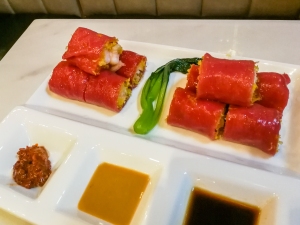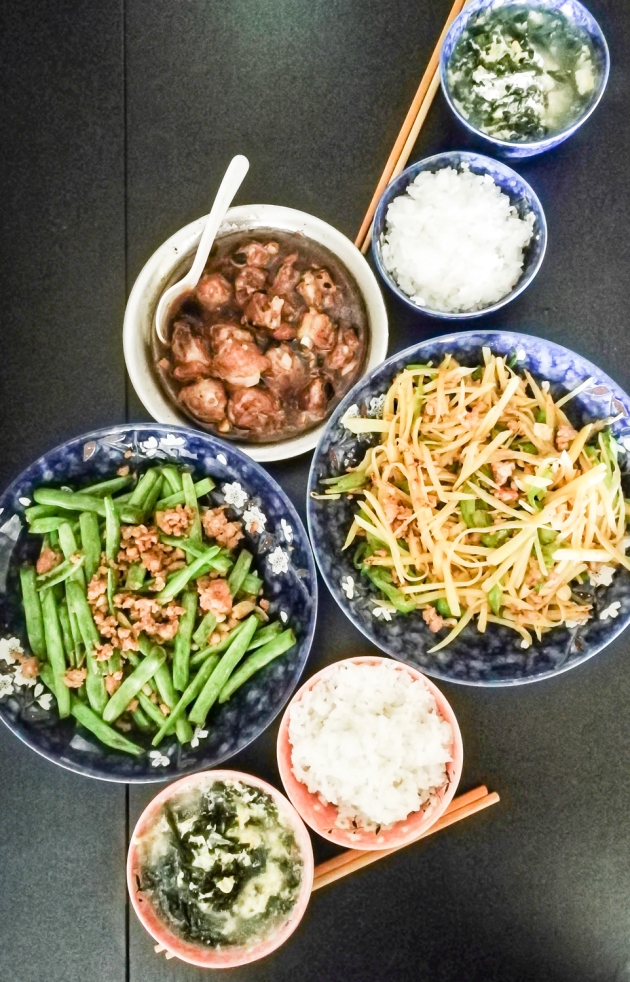Ah, food, my favourite subject ever. I’m surprised myself that the first post in the China mini-series wasn’t about food but about transportation, but it’s never too late to talk about food, so let’s get started.
There’s nothing too extravagant or unusual about eating and dining in Wuhan. As someone who grew up eating Chinese food and LOVES it, I couldn’t complain about having it every day. Compared to other provinces of China, Hubei (the province that Wuhan belongs to) doesn’t have a very well-defined “characteristic cuisine”, per se. Take Sichuanese or Cantonese cuisine, for example. The defining characteristic of Sichuanese cuisine is its “numbing spiciness” whereas for Cantonese cuisine, it’s the preservation of the original “freshness” of the raw ingredients. Nothing really comes to mind if you mention “cuisine of Hubei”. It’s not particularly spicy or sweet or salty or anything, and at least in terms of overall taste, it seems to be a blend of all types of cuisines.

Lotus root stuffed with glutinous rice, one of the regional specialties of Hubei province.
That is not to say that there’s nothing special about food here in Wuhan. Hubei cuisine uses a lot of lotus root in their cooking, and I’m not surprised because I see a lot of lotus ponds in the city as I walk around. As a result, I’ve had the pleasure of trying a few lotus-based dishes, including lotus root pork bone soup, lotus root tip, and glutinous rice-stuffed lotus root (photo shown above). You’d also see people selling lotus seed pods everywhere and they’re actually pretty good if they’re freshly harvested! (Some people may not feel comfortable with their appearance though…)

Lotus seed pods in their original form (left) and after being extracted (right). The shell of the pods themselves need to be peeled, exposing a white interior with a core that is sometimes bitter and should be avoided.
Of course we can’t forget the signature “hot dry noodles” of Wuhan (literal translation), which means…breakfast! If you’re not too familiar with Chinese-style breakfast, it’s very different than what you’d have in either North America or Europe. Stuff like pancakes, eggs/omelettes (not as uncommon), bacon, sausage, ham, waffles, etc…nope, not getting any of that. Instead, typical Chinese breakfast involves one or more of the following (or a variation of it): congee, dumplings, buns, and noodles. Often there are street vendors along the side of the road that I take to get to the bus station, and it’s super convenient to grab what you want and either eat it along the way or while waiting for the bus.

Breakfast stands on the side of the street. The first lady sells hot dry noodles and cold noodles, and the other vendors sell dumplings, buns, fried dough, etc…
My favourite breakfast item has been pan-fried dumplings from a particular vendor, but lately I’ve started getting hot dry noodles from another stand. I actually love hot dry noodles, but they’re just a bit more inconvenient to eat while walking, so I sometimes opt not to get it. What ARE hot dry noodles, you ask? They are a very popular Wuhan street food, though also sold at many sit-down places, that is most often eaten for breakfast (or whenever you want, really). As the name implies, they are VERY HOT (temperature), as they are strained right out of boiling water, and VERY DRY, even though a sesame-based sauce is poured onto the noodles. A variety of sides can be added, including pickled radish, pickled green beans, scallions, etc. A good bowl of hot dry noodles to get the day started – sounds like a perfect morning to me!

Hot dry noodles! Not the ones I got from the lady at the breakfast stand, but they’re similar. I like it with a lot of sesame paste and a lot of scallions. One bowl is super filling!
There are also lots of regional cuisines all over the place. J (the boyfriend) and I recently discovered a nice Cantonese restaurant that serves authentic dim sum – MY STAPLE as a Cantonese! – and a variety of Cantonese dishes, like white-cut chicken and stir-fried beef noodles. The menu is a bit limited but it’s got the most essential items, so it’s definitely a necessary dose of home once in a while. We also frequent this small restaurant that specializes in noodles of the Xi’an region in Shaanxi province. It’s close to where we live, cheap, and everything we’ve tried so far has been super delicious. I especially like their “biang biang” noodles, which are really wide (about the width of a waist belt) and really long. They were as good as the ones I’ve tried in Xi’an, though I should bring my friend from Xi’an to this place next time she visits, to validate its authenticity. In contrast to the Cantonese restaurant, this one has quite an extensive menu, so it’ll take many more visits to try everything! If you’re in the mood for something super spicy, there are quite a few Sichuanese restaurants, some specializing in hot pots. Recently we visited a place that serves “mao cai”, which is just a mix of everything you’d have at a hot pot all in one bowl at once. “Slightly spicy” is often already too spicy for us, so next time we’ll skip spiciness and just add chili sauce ourselves, thank you very much!
-

-
Signature red rice rolls with shrimp
-

-
“Little boat” congee and steamed chicken feet
-

-
Cantonese “white-cut” chicken with ginger dip
-

-
Ham hock flower
-

-
Biangbiang noodles with barbecued meat sauce
-

-
“Mao cai” of Chengdu
(Click to view the full image.) Cantonese cuisine (top row), Shaanxi cuisine (bottom left and middle), and Sichuanese “mao cai” (bottom right). We’re also discovering new restaurants every week!
Of course, these are just a few of the many types of regional Chinese cuisine scattered around the area. There are also international options, like Italian, Japanese (man I miss good sushi), Korean, and French. These options are rather limited, however, and they tend to be on the pricey side, so they’re more like a treat/splurge/indulgence for special occasions only. I’m craving a good steak right now…*drools*
Do we eat out all the time? You ask. Oh, we certainly do not eat out all the time, or else we’d be broke. Since J works at a university and I live close by, we like to go to one of the many university canteens for dinner. (That doesn’t count as eating out…does it?) The canteen themselves are quite an impressive sight and so much larger than the canteens or cafeterias I’ve been to in Canada or in Europe. And the variety of food is insane – from noodles to barbecue to soup dumplings to bi bim bap, if you could name it, you could probably find it! It’s almost like a hawker center in Singapore, and whereas you’d usually expect canteen food to be subpar, the food here is not bad at all! For less than $3 Canadian I can get a decent rice dish or several small portions of meats and vegetables. Maybe I should consider enrolling as a mature student in a Chinese university…just for the food 😛

One of the larger university canteen at the Huazhong University of Science and Technology. I heard there are around 30 canteens of various sizes at this university and I’ve definitely been to no fewer than 5. They’re only open at specific times during lunch and dinner and so they’re usually super crowded. You’d be lucky if you didn’t have to share a table with someone.
Oh, we do cook. Even though the kitchen at my small apartment is tiny, it is still a functional kitchen and from the first day I moved in, I intended to make good use of it. The thing is, after I started working, I’m too tired to cook when I get home (around 7pm by the time I arrive). Cooking at home now mostly occurs on weekends, when J and I would take turn cooking and washing the dishes. One thing I did notice when we did groceries was that meat and fish are rather expensive here. Well, compared to fruits and vegetables, that is. While 1 jin (the unit of measurement used here, equivalent to half a kg) of green beans cost 4 yuan (approximately 80 Canadian cents, all prices hereafter are stated in Canadian dollar), 1 jin of potatoes cost 60 cents, and a large watermelon costs $2.5, 1 jin of beef may cost around $6. And it isn’t even high-quality beef! Quite ridiculous, if you ask me. As a result, my meat intake has decreased significantly and I’ve been eating a lot more vegetables recently. Healthier, I suppose, but I do miss my chicken and salmon sometimes!

First home-cooked meal after moving into my apartment! Steamed spare ribs, stir-fried potato, and green beans with ground pork. Add a side of egg drop seaweed soup, please. Very satisfying!
Meanwhile, it’s almost dinner time and I’m waiting for J to come home after his basketball game so we can make our only home-cooked meal of the week. And I’ve got some lotus seed pods next to me that we gotta finish tonight. Life is good 🙂



























